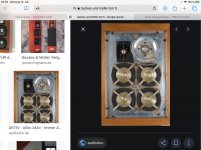Hi,
There used to be a project of a servo subwoofer using a capacitive sensor put on the inside of the driver's voice coil (and pole piece). Does anyone have the project link?
Thanks and Regards,
WA
There used to be a project of a servo subwoofer using a capacitive sensor put on the inside of the driver's voice coil (and pole piece). Does anyone have the project link?
Thanks and Regards,
WA
Since nobody has come up to post an answer.... Are you sure it was capacitative? Seems unlikely given the distances involved in the motion of the cone assembly. Of course, there have been numerous types of sensor suggested over the years.
Could you be thinking of a driver which had a special winding added to the voice coil former that provided a motional feedback signal? There's a Sony driver that fits that description.
In another active thread is a discussion of the latest-and-greatest manufacturer to try MFB and they are using an extra winding to provide the negative feedback. Large pro-sound speakers. Discussed towards end (at present moment in time) of:
Servo controlled subwoofers - why arent they used more often
B.
Could you be thinking of a driver which had a special winding added to the voice coil former that provided a motional feedback signal? There's a Sony driver that fits that description.
In another active thread is a discussion of the latest-and-greatest manufacturer to try MFB and they are using an extra winding to provide the negative feedback. Large pro-sound speakers. Discussed towards end (at present moment in time) of:
Servo controlled subwoofers - why arent they used more often
B.
Last edited:
Many years ago there was a paper pasi.nuutinmaki "Capacitive motional feedback for loudspeakers" in the net. The original side servospeaker.com doesn't exist any more but a copy of this pdf you may download with the google link here:
https://www.google.com/url?sa=t&rct...citivo_2.pdf&usg=AOvVaw3W_Q5Ln6rXR-mpESsq07KK
https://www.google.com/url?sa=t&rct...citivo_2.pdf&usg=AOvVaw3W_Q5Ln6rXR-mpESsq07KK
Yes. Interesting. The capacitor plates are sliding up and down relative to one another, not getting closer and further away.
Right off the top of my head, I can think of a bunch or reasons it seems unfeasible. All kinds of non-linear physics involved. Hard to control the relative motions of the plates in a moving cone assembly. You need a signal (RF?) which is influenced by the change in capacitance. Humidity in the air.
By comparison, you can take a little piece of sheetmetal and create a photocell mask that changes percent of masking with the cone motion. Which mechanical assembly makes more sense? Hint: neither makes too much sense. And that's why these mechanical approaches are cheap, but not nearly as good as a modern accelerometer.
B.
Right off the top of my head, I can think of a bunch or reasons it seems unfeasible. All kinds of non-linear physics involved. Hard to control the relative motions of the plates in a moving cone assembly. You need a signal (RF?) which is influenced by the change in capacitance. Humidity in the air.
By comparison, you can take a little piece of sheetmetal and create a photocell mask that changes percent of masking with the cone motion. Which mechanical assembly makes more sense? Hint: neither makes too much sense. And that's why these mechanical approaches are cheap, but not nearly as good as a modern accelerometer.
B.
Capacitive motional feedback for loudspeakers - PDF Free Download
There is a patent by same author, I think, Nuutinmaki.
I think that a capacitive sensor gives displacement data.
There is a patent by same author, I think, Nuutinmaki.
I think that a capacitive sensor gives displacement data.
Yes, likely position, at least in theory. Sounds great unless the MFB system really tries to deal with position down to DC.
But it may well be rather unstable to set the at-rest point given all the variable factors in play with this system.
B.
But it may well be rather unstable to set the at-rest point given all the variable factors in play with this system.
B.
They are not plates, they are cylinders. The outer cylinder is put on the inside of voice coil, a metal foil can be pasted on the inside of coil or even conductive ink. The inside cylinder has to be made, it should not be difficult to make a cylinder place concentrically with the voice coil. I did not understand the non linearity in the technique.All kinds of non-linear physics involved. Hard to control the relative motions of the plates in a moving cone assembly. You need a signal (RF?) which is influenced by the change in capacitance. Humidity in the air.
B.
Now, it does need a high voltage source, now that may be a problem.
Why does this technique compare position from sensor and voltage from the sound source. Shouldn't the sensor signal be converted to acceleration?
The voltage fed to the speaker represents acceleration, right?
The voltage fed to the speaker represents acceleration, right?
- Home
- Loudspeakers
- Subwoofers
- Capacitive sensor servo subwoofer
